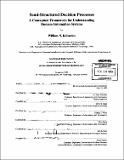| dc.contributor.advisor | R. John Hansman. | en_US |
| dc.contributor.author | Kaliardos, William N | en_US |
| dc.contributor.other | Massachusetts Institute of Technology. Dept. of Aeronautics and Astronautics. | en_US |
| dc.date.accessioned | 2006-03-29T18:22:11Z | |
| dc.date.available | 2006-03-29T18:22:11Z | |
| dc.date.copyright | 1999 | en_US |
| dc.date.issued | 1999 | en_US |
| dc.identifier.uri | http://hdl.handle.net/1721.1/32182 | |
| dc.description | Thesis (Ph.D.)--Massachusetts Institute of Technology, Dept. of Aeronautics and Astronautics, 1999. | en_US |
| dc.description | Includes bibliographical references (p. 191-199). | en_US |
| dc.description.abstract | The purpose of this work is to improve understanding of existing and proposed decision systems, ideally to improve the design of future systems. A "decision system" is defined as a collection of information-processing components-often involving humans and automation (e.g., computers)-that interact towards a common set of objectives. Since a key issue in the design of decision systems is the division of work between humans and machines (a task known as "function allocation"), this thesis is primarily intended to help designers incorporate automation more appropriately within these systems. This thesis does not provide a design methodology, but introduces a way to qualitatively analyze potential designs early in the system design process. A novel analytical framework is presented, based on the concept of "semi-Structured" decision processes. It is believed that many decisions involve both well-defined "Structured" parts (e.g., formal procedures, traditional algorithms) and ill-defined "Unstructured" parts (e.g., intuition, judgment, neural networks) that interact in a known manner. While Structured processes are often desired because they fully prescribe how a future decision (during "operation") will be made, they are limited by what is explicitly understood prior to operation. A system designer who incorporates Unstructured processes into a decision system understands which parts are not understood sufficiently, and relinquishes control by deferring decision-making from design to operation. Among other things, this design choice tends to add flexibility and robustness. The value of the semi-Structured framework is that it forces people to consider system design concepts as operational decision processes in which both well-defined and ill-defined components are made explicit. This may provide more insight into decision systems, and improve understanding of the implications of design choices. The first part of this thesis defines the semi-Structured process and introduces a diagrammatic notation for decision process models. In the second part, the semi-Structured framework is used to understand and explain highly evolved decision system designs (these are assumed to be representative of "good" designs) whose components include feedback controllers, alerts, decision aids, and displays. Lastly, the semi-Structured framework is applied to a decision system design for a mobile robot. | en_US |
| dc.description.statementofresponsibility | by William N. Kaliardos. | en_US |
| dc.format.extent | 199 p. | en_US |
| dc.format.extent | 11594442 bytes | |
| dc.format.extent | 11605254 bytes | |
| dc.format.mimetype | application/pdf | |
| dc.format.mimetype | application/pdf | |
| dc.language.iso | eng | en_US |
| dc.publisher | Massachusetts Institute of Technology | en_US |
| dc.rights | M.I.T. theses are protected by copyright. They may be viewed from this source for any purpose, but reproduction or distribution in any format is prohibited without written permission. See provided URL for inquiries about permission. | en_US |
| dc.rights.uri | http://dspace.mit.edu/handle/1721.1/7582 | |
| dc.subject | Aeronautics and Astronautics. | en_US |
| dc.title | Semi-structured decision processes : a conceptual framework for understanding human-automation systems | en_US |
| dc.type | Thesis | en_US |
| dc.description.degree | Ph.D. | en_US |
| dc.contributor.department | Massachusetts Institute of Technology. Department of Aeronautics and Astronautics | |
| dc.identifier.oclc | 44598056 | en_US |
